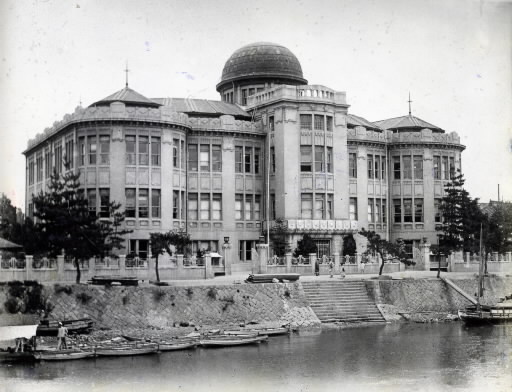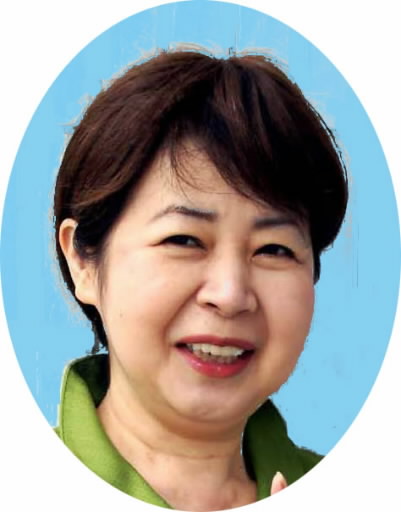Hiroshima’s contribution to food culture tied to A-bomb Dome
Sep. 3, 2010
by Shinobu Kikuraku
Improving the quality of products
A special exhibition to explore the changes that have occurred in the city of Hiroshima through a focus on the Atomic Bomb Dome and its former identity, the Hiroshima Prefectural Industrial Promotion Hall, has opened at the Hiroshima Prefectural Museum of Art. The exhibition, titled "From Hiroshima to Hiroshima," was organized by the Chugoku Shimbun and other entities. It will run until September 20.
This article will outline the 30-year history of the hall prior to the atomic bombing by citing Chugoku Shimbun coverage undertaken before World War II.
The former Hiroshima Prefectural Industrial Promotion Hall was designed by the Czech architect Jan Letzel and completed on April 5, 1915. It was first dubbed the Hiroshima Prefectural Commercial Exhibition Hall. It was a three-story building made of brick, and became a prominent site in Hiroshima. The building was also nicknamed the "tall, white building."
The first director of the hall, Hisanobu Yoshida, was a graduate of Tokyo Commercial School (now Hitotsubashi University) and a man of ideas. In coverage by the Chugoku Shimbun, he regularly shared suggestions for promoting items produced in Hiroshima, such as "The bottles of sake [Japanese rice wine] produced in Hiroshima should be improved to meet the drink's high standards of quality." (July 2, 1916) He held trade fairs in the hall with the aim of improving the quality of the products and motivating the makers.
Mr. Yoshida also contacted artists in Hiroshima to promote art. He formed the Hiroshima Prefecture Art Association on June 22, 1916 and became chairman of the association. The association organized an art exhibition for artists of Hiroshima Prefecture, in which the works chosen for display were received from various groups. His motto was: "Beauty and practicality can coexist." (December 9, 1916). He argued that art was useful in producing quality products.
After Japan entered World War I, German soldiers were captured in Tsingtao, China and more than 500 were held at an internment camp on Ninoshima Island, out in Hiroshima Bay. This influx of German soldiers led to an exhibition of specialty items produced by the prisoners. At this event, held in the hall in 1919, Herman Wolschke sold sausage and Karl Juchheim sold Baumkuchen, the first cake of this kind to appear in Japan.
The Chugoku Shimbun reported that "the hall received a record number of visitors since the grand opening of the building." (March 7, 1919) As Herman Wolschke spoke Japanese, he provided technical guidance to a local ham factory. (December 28, 1919) After their release, both Herman Wolschke and Karl Juchheim worked for Meidi-Ya, a food production company in Tokyo. Once they became independent businessmen, they conveyed their superb skills and recipes for food production across Japan. Some of the German soldiers remained in Hiroshima even after they were released. Waldemar Ahters, one such soldier, worked for the Hiroshima plant of the Japan Steel Works. He also delivered a talk entitled "The World of Labor: Comparisons Between Germany and Japan" at regular meetings of the local business community held at the hall. (February 27, 1920)
Pushing the export of products
In 1921, the Hiroshima Prefectural Commercial Exhibition Hall changed its name to the Hiroshima Prefectural Products Exhibition Hall. The hall displayed Hiroshima products in exhibitions and promoted their export to other countries. For a "Peace Exhibition" held in Tokyo in 1922, which was visited by the British Crown Prince, Etsuro Toyoshima, then director of the hall, went to Tokyo to display products from Hiroshima. (February 21, 1922) At this exhibition, a canned food company in Hiroshima won the gold prize in one food category for its vegetable pickles and mushroom pickles. During the Taisho Era (1912-1926), Hiroshima produced the most canned food in Japan.
Emperor Showa also visited the hall when he was still Crown Prince. During a tour he took to western Japan, he came to the hall on May 25, 1926. Shinzaburo Minematsu was director of the hall at the time and he explained the Hiroshima products to the future emperor. Mr. Minematsu served as director for 12 years, the longest stewardship among directors of the hall. In 1933, with the aim of promoting exports to Manchukuo (now, a part of northeastern China), the Hiroshima Prefectural Products Exhibition Hall changed its name to the Hiroshima Prefectural Industrial Promotion Hall. A showy celebration was held at a top restaurant in town. (March 21, 1934)
However, with the Sino-Japanese war grinding on, the elegant gates to the hall designed by Jan Letzel were appropriated by the Japanese military as a source of steel for the war effort. (June 20, 1941) Two years after Japan sparked the Pacific War with the United States, the whole hall was taken over to house war-related offices. (November 23, 1943) The last event held at the hall took place in December 1943, "The Holy War Great Works of Art Exhibition." The war thus forced an end to the intended function of the hall. Then, on August 6, 1945, the atomic bomb exploded almost directly above the building.
Profile
Shinobu Kikuraku
Shinobu Kikuraku was born in Miyoshi in 1958. She graduated from the Graduate School of Social Science, Hiroshima University. She is a Jan Letzel researcher and now works for the Hiroshima Peace Culture Foundation.
(Originally published on September 1, 2010)
Improving the quality of products
A special exhibition to explore the changes that have occurred in the city of Hiroshima through a focus on the Atomic Bomb Dome and its former identity, the Hiroshima Prefectural Industrial Promotion Hall, has opened at the Hiroshima Prefectural Museum of Art. The exhibition, titled "From Hiroshima to Hiroshima," was organized by the Chugoku Shimbun and other entities. It will run until September 20.
This article will outline the 30-year history of the hall prior to the atomic bombing by citing Chugoku Shimbun coverage undertaken before World War II.
The former Hiroshima Prefectural Industrial Promotion Hall was designed by the Czech architect Jan Letzel and completed on April 5, 1915. It was first dubbed the Hiroshima Prefectural Commercial Exhibition Hall. It was a three-story building made of brick, and became a prominent site in Hiroshima. The building was also nicknamed the "tall, white building."
The first director of the hall, Hisanobu Yoshida, was a graduate of Tokyo Commercial School (now Hitotsubashi University) and a man of ideas. In coverage by the Chugoku Shimbun, he regularly shared suggestions for promoting items produced in Hiroshima, such as "The bottles of sake [Japanese rice wine] produced in Hiroshima should be improved to meet the drink's high standards of quality." (July 2, 1916) He held trade fairs in the hall with the aim of improving the quality of the products and motivating the makers.
Mr. Yoshida also contacted artists in Hiroshima to promote art. He formed the Hiroshima Prefecture Art Association on June 22, 1916 and became chairman of the association. The association organized an art exhibition for artists of Hiroshima Prefecture, in which the works chosen for display were received from various groups. His motto was: "Beauty and practicality can coexist." (December 9, 1916). He argued that art was useful in producing quality products.
After Japan entered World War I, German soldiers were captured in Tsingtao, China and more than 500 were held at an internment camp on Ninoshima Island, out in Hiroshima Bay. This influx of German soldiers led to an exhibition of specialty items produced by the prisoners. At this event, held in the hall in 1919, Herman Wolschke sold sausage and Karl Juchheim sold Baumkuchen, the first cake of this kind to appear in Japan.
The Chugoku Shimbun reported that "the hall received a record number of visitors since the grand opening of the building." (March 7, 1919) As Herman Wolschke spoke Japanese, he provided technical guidance to a local ham factory. (December 28, 1919) After their release, both Herman Wolschke and Karl Juchheim worked for Meidi-Ya, a food production company in Tokyo. Once they became independent businessmen, they conveyed their superb skills and recipes for food production across Japan. Some of the German soldiers remained in Hiroshima even after they were released. Waldemar Ahters, one such soldier, worked for the Hiroshima plant of the Japan Steel Works. He also delivered a talk entitled "The World of Labor: Comparisons Between Germany and Japan" at regular meetings of the local business community held at the hall. (February 27, 1920)
Pushing the export of products
In 1921, the Hiroshima Prefectural Commercial Exhibition Hall changed its name to the Hiroshima Prefectural Products Exhibition Hall. The hall displayed Hiroshima products in exhibitions and promoted their export to other countries. For a "Peace Exhibition" held in Tokyo in 1922, which was visited by the British Crown Prince, Etsuro Toyoshima, then director of the hall, went to Tokyo to display products from Hiroshima. (February 21, 1922) At this exhibition, a canned food company in Hiroshima won the gold prize in one food category for its vegetable pickles and mushroom pickles. During the Taisho Era (1912-1926), Hiroshima produced the most canned food in Japan.
Emperor Showa also visited the hall when he was still Crown Prince. During a tour he took to western Japan, he came to the hall on May 25, 1926. Shinzaburo Minematsu was director of the hall at the time and he explained the Hiroshima products to the future emperor. Mr. Minematsu served as director for 12 years, the longest stewardship among directors of the hall. In 1933, with the aim of promoting exports to Manchukuo (now, a part of northeastern China), the Hiroshima Prefectural Products Exhibition Hall changed its name to the Hiroshima Prefectural Industrial Promotion Hall. A showy celebration was held at a top restaurant in town. (March 21, 1934)
However, with the Sino-Japanese war grinding on, the elegant gates to the hall designed by Jan Letzel were appropriated by the Japanese military as a source of steel for the war effort. (June 20, 1941) Two years after Japan sparked the Pacific War with the United States, the whole hall was taken over to house war-related offices. (November 23, 1943) The last event held at the hall took place in December 1943, "The Holy War Great Works of Art Exhibition." The war thus forced an end to the intended function of the hall. Then, on August 6, 1945, the atomic bomb exploded almost directly above the building.
Profile
Shinobu Kikuraku
Shinobu Kikuraku was born in Miyoshi in 1958. She graduated from the Graduate School of Social Science, Hiroshima University. She is a Jan Letzel researcher and now works for the Hiroshima Peace Culture Foundation.
(Originally published on September 1, 2010)









